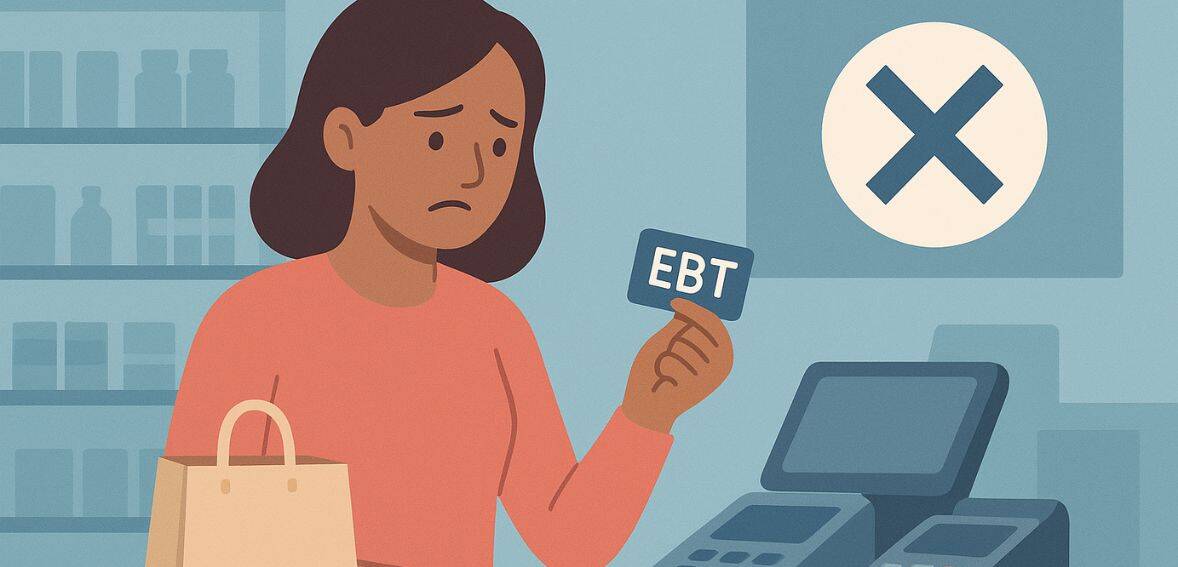
By admin October 2, 2025
More than just a way to make payments, Electronic Benefit Transfer (EBT) is an important tool that helps millions of low-income households buy basic food items. By taking EBT, retailers can increase their customer base, build community trust, and promote equity in food access.
However, many retailers make mistakes that can lead to financial penalties, unhappy customers, and even disqualification from the Supplemental Nutrition Assistance Program (SNAP) because they don’t fully understand how these transactions operate. EBT has distinct guidelines and obligations in contrast to traditional debit or credit card payments.
Retailers who undervalue these needs frequently find that minor errors can escalate into major problems. Building a compliant, reliable, and effective EBT process begins with understanding common pitfalls.
Misclassifying Eligible Items

Misclassifying what can and cannot be bought with EBT is one of the most common errors made by retailers. For instance, only food items intended for consumption and preparation at home are eligible for SNAP benefits.
Alcohol, tobacco, hot foods, and non-food items like paper goods or soap are not allowed. However, clerks occasionally neglect to enforce these distinctions in hectic retail settings, either by accident or as a result of customer pressure.
Even though these mistakes might not seem like much at the time, they can accumulate to form a pattern of infractions that draws attention from regulators. To prevent these expensive mistakes, retailers must train employees on item eligibility and maintain systems that flag restricted items.
Failing to Maintain Proper Equipment
Specialized terminals capable of securely processing benefits are necessary for EBT transactions. Retailers frequently make the error of failing to test or maintain their point-of-sale systems regularly. Customers who depend significantly on their benefits may become frustrated when transactions are declined due to outdated equipment.
Additionally, some retailers put off updating their systems to accept both EBT and modern payment methods, which may lead to technical issues and longer checkout times. In the worst situations, a broken terminal during busy times undermines consumer confidence and causes needless delays. Maintaining equipment properly ensures seamless transactions each time a customer swipes their card and shows a retailer’s dedication to accessibility and compliance. It’s not just about efficiency.
Inadequate Staff Training

When it comes to EBT compliance, people are frequently the weakest link. Retailers occasionally make the costly error of assuming that cashiers will automatically distinguish between EBT transactions and traditional payments. For example, a cashier who is not aware of the restriction might let a customer use SNAP benefits to buy a hot prepared meal.
When clients use both cash and EBT, some might handle split payments incorrectly. Without thorough training, employees are ill-equipped to handle complex situations, which leads to mistakes that the company, not the employee, must bear. Frequent training, refreshers, and open communication enable employees to confidently handle EBT transactions and shield the company from recurring compliance errors.
Overlooking Settlement and Reconciliation
Similar to credit or debit payments, EBT transactions need to be carefully settled and reconciled. Some retailers, however, ignore this procedure because they believe EBT funds will be deposited automatically and without any problems.
Customers and store owners may become confused by differences that occur when transactions are not reconciled. A failed settlement, for instance, might cause the state to postpone payment, temporarily depriving retailers of their money.
Inadequate reconciliation procedures erode business planning and skew financial records over time. These delays may put a strain on cash flow for smaller retailers with narrow profit margins. A daily settlement review routine guarantees accuracy, upholds confidence, and avoids the needless hassles of misplaced or misutilized funds.
Ignoring State-Specific Regulations
Although states have the power to impose additional requirements, EBT acceptance is governed by federal regulations through SNAP. Retailers who disregard these variances frequently end up unintentionally breaking the law.
For example, certain states might demand stricter documentation or particular signage for transactions. Others might establish special auditing protocols. These variations are usually overlooked by retailers who are growing across state lines, using a one-size-fits-all strategy that ignores local quirks.
Fines or, in the worst situations, the suspension of EBT privileges could follow from such oversights. It takes proactive work to understand state-specific regulations, but doing so enables retailers to run efficiently, stay in compliance, and forge closer bonds with the communities they serve across several locations.
Poor Customer Communication
Customers using EBT often encounter stigma or confusion when making purchases, and retailers sometimes mishandle these sensitive interactions. A lack of clear communication at checkout can leave customers embarrassed, especially if a purchase is denied without explanation.
Retailers who fail to post signs indicating EBT acceptance or do not inform customers of eligible items create unnecessary stress. Poor communication can also arise from untrained staff who handle declined transactions insensitively.
Retailers that prioritize respectful, informative communication not only improve the shopping experience but also strengthen community trust. Clear, empathetic dialogue ensures customers feel welcome and supported, while reinforcing the store’s reputation as a reliable partner in food access.
Mishandling Split Transactions

The requirement to divide payments between eligible and non-eligible items is a unique aspect of using EBT. Retailers frequently handle these situations incorrectly, either by charging cash portions incorrectly or by permitting ineligible items to be processed under EBT.
Although split transactions demand attention to detail, they could be processed incorrectly by staff members who are hurried or lack proper training. Customers are irritated by this error since they have to make additional payments or correct charges.
Repeated mistakes erode client loyalty over time and create compliance issues. In order to ensure that both sides of the transaction are processed accurately, legally, and with the least amount of disruption at checkout, it is imperative to develop clear procedures for handling split payments.
Neglecting Security Protocols
Since benefits are linked to vulnerable populations that rely on their integrity, security is essential to EBT. Retailers risk regulatory fines and harm to their reputation if they neglect to protect customer PIN entries or improperly store sensitive data.
Simple errors like not positioning terminals to protect customer privacy can increase the likelihood of identity theft or fraud. When retailers fail to update their systems against cyber threats, EBT processing becomes susceptible to breaches, leading to more serious problems.
Security procedures are a non-negotiable duty for retailers; they are not an option. Protecting consumers entails preserving their benefits, dignity, and the trust that upholds enduring ties between the community and the store.
Mismanaging Refunds and Voids
Retailers frequently mishandle the rules governing how to handle refunds and voids in EBT transactions. Although it is strictly prohibited, some people try to give cash refunds for SNAP purchases. Others handle voids improperly, which results in inaccurate or delayed reimbursements. If benefits are not promptly restored, these errors can damage customer trust in addition to violating compliance.
In order to ensure that customers are treated fairly and that funds are managed appropriately, refunds and voids must be handled transparently and in accordance with program regulations. Clear refund policies for EBT help retailers avoid noncompliance issues and the administrative hassles that come with poorly handled reversals, while also enhancing their credibility.
Failing to Monitor for Fraud
Retailers occasionally fail to see their responsibility to keep an eye on EBT transactions for indications of fraud. Businesses are subject to severe penalties for engaging in fraudulent activities, such as allowing unauthorized purchases or trafficking benefits for cash.
Store owners themselves may be complicit in certain cases, but employees who are not aware of warning signs are more likely to allow problems to persist. Fraudulent patterns might continue unnoticed without adequate monitoring, eventually attracting the attention of authorities.
In addition to penalties, fraud harms actual consumers and damages the SNAP program’s reputation. Retailers who maintain vigilance, examine transaction trends, and foster accountability among employees exhibit honesty and accountability, guaranteeing that their companies continue to be dependable community partners.
Technology Gaps in Rural or Smaller Stores

Smaller or more rural retailers frequently use outdated systems that are unable to meet the demands of EBT. Slower service and frequent transaction errors may result from these stores’ reliance on outdated terminals or spotty internet connectivity.
When their benefits don’t go through smoothly, customers who already have trouble getting food may feel left out. Retailers sometimes undervalue the significance of system upgrades until malfunctions start to reduce profits.
Even though modernization can be expensive, the long-term gains in accuracy, efficiency, and customer satisfaction greatly exceed the initial outlay. Early resolution of these technological gaps aids merchants in avoiding repeat errors that irritate consumers and undermine their confidence in the purchasing process.
Lack of Community Engagement
EBT transactions are lifelines for families in need, but retailers who see them as just another payment option frequently fail to see the broader context. Customers and stores become more distant when community engagement is neglected, whether through partnerships with local organizations, education, or clear communication.
For example, customers who already encounter obstacles may become resentful if there is unclear signage or no multilingual assistance. Businesses that accept EBT as a component of their community role, on the other hand, foster goodwill and loyalty. When retailers view EBT as a chance to serve with responsibility and dignity rather than as a burden, mistakes are less likely to occur.
Overdependence on Third-Party Providers
For the management of their EBT systems, certain retailers mainly depend on outside processors or service providers. Outsourcing can be effective, but it also carries risk if retailers don’t pay attention to or understand the specifics.
The retailer is still responsible for compliance failures even if an outside provider performs reconciliation incorrectly or updates equipment too slowly. Because of this over-reliance, minor issues may quickly become more serious before management even realizes it.
Retailers must find a balance between using outside expertise and continuing to be actively involved in system management, audits, and oversight. Assuming responsibility for EBT procedures lowers vulnerability and guarantees that the company, not outside partners, is always held accountable.
While outsourcing EBT processing can save time, relying too much on third-party EBT providers without fully understanding the tradeoffs can leave retailers vulnerable to compliance lapses, hidden fees, or loss of control over critical operations.
Not Preparing for Audits
EBT retailers must prepare for audits, but many don’t do much until they are being examined. Due to the possibility of incomplete records or undocumented policies, this reactive approach causes needless stress.
Businesses may be subject to fines or corrective measures when auditors find gaps that could have been prevented with greater planning. Incomplete training logs, missing settlement records, or improper transaction classification are examples of common audit problems.
The goal of audit preparation is to show professionalism and dedication to compliance, not to instill fear. Retailers who keep well-organized records and prepare for scrutiny develop resilience, making an audit a chance to demonstrate their dependability rather than reveal flaws.
Underestimating the Impact of Mistakes

Underestimating the cumulative effect of minor mistakes in EBT handling is arguably the biggest error that retailers make. Even though one incorrectly classified item might not seem like much, when it happens repeatedly over several weeks or months, it becomes a pattern that regulators cannot ignore.
Although mishandled refunds, inadequate customer service, or equipment malfunctions might seem like separate incidents, taken together, they give the impression that the company is unreliable.
Beyond monetary fines, retailers run the risk of losing the trust of their customers and possibly even their permission to accept EBT. It’s critical to acknowledge the significance of these errors. Retailers safeguard their income, their brand, and their contribution to community food security by giving EBT compliance the attention it requires.
Conclusion
Managing EBT transactions calls for more than just technical expertise; it calls for transparency, thought, and regard for the communities that rely on these advantages. Errors in communication, reconciliation, training, or classification can swiftly damage credibility and lead to compliance problems that risk a retailer’s SNAP status.
However, retailers can turn EBT from a risk into a strength by paying close attention to details, investing in staff training, and maintaining a dedication to transparency. The objective is to support food access with dignity and integrity, not just to process payments. Retailers strengthen their position as essential collaborators in the larger goal of food equity and community well-being by steering clear of typical mistakes.